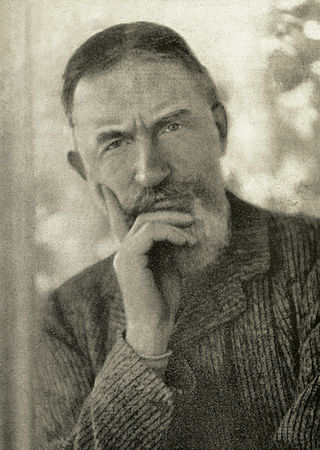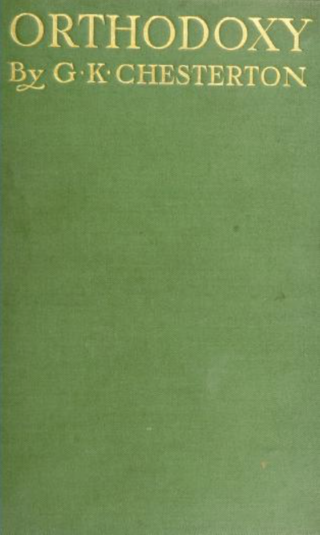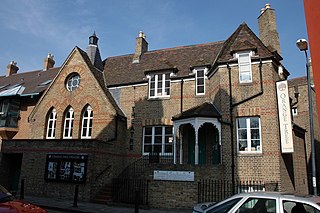
Gilbert Keith Chesterton was an English author, philosopher, Christian apologist, and literary and art critic.

George Bernard Shaw, known at his insistence as Bernard Shaw, was an Irish playwright, critic, polemicist and political activist. His influence on Western theatre, culture and politics extended from the 1880s to his death and beyond. He wrote more than sixty plays, including major works such as Man and Superman (1902), Pygmalion (1913) and Saint Joan (1923). With a range incorporating both contemporary satire and historical allegory, Shaw became the leading dramatist of his generation, and in 1925 was awarded the Nobel Prize in Literature.

In the history of the United Kingdom and the British Empire, the Victorian era was the reign of Queen Victoria, from 20 June 1837 until her death on 22 January 1901. Slightly different definitions are sometimes used. The era followed the Georgian era and preceded the Edwardian era, and its later half overlaps with the first part of the Belle Époque era of continental Europe.

William Paley was an English Anglican clergyman, Christian apologist, philosopher, and utilitarian. He is best known for his natural theology exposition of the teleological argument for the existence of God in his work Natural Theology or Evidences of the Existence and Attributes of the Deity, which made use of the watchmaker analogy.

Joseph Glanvill was an English writer, philosopher, and clergyman. Not himself a scientist, he has been called "the most skillful apologist of the virtuosi", or in other words the leading propagandist for the approach of the English natural philosophers of the later 17th century. In 1661 he predicted "To converse at the distance of the Indes by means of sympathetic conveyances may be as natural to future times as to us is a literary correspondence."

Annie Besant was a British socialist, theosophist, freemason, women's rights and Home Rule activist, educationist, and campaigner for Indian nationalism. She was an ardent supporter of both Irish and Indian self-rule. She became the first female president of the Indian National Congress in 1917.

Ēostre is a West Germanic spring goddess. The name is reflected in Old English: *Ēastre, Old High German: *Ôstara, and Old Saxon: *Āsteron. By way of the Germanic month bearing her name, she is the namesake of the festival of Easter in some languages. The Old English deity Ēostre is attested solely by Bede in his 8th-century work The Reckoning of Time, where Bede states that during Ēosturmōnaþ, pagan Anglo-Saxons had held feasts in Ēostre's honour, but that this tradition had died out by his time, replaced by the Christian Paschal month, a celebration of the resurrection of Jesus.

Apologetics is the religious discipline of defending religious doctrines through systematic argumentation and discourse. Early Christian writers who defended their beliefs against critics and recommended their faith to outsiders were called Christian apologists. In 21st-century usage, apologetics is often identified with debates over religion and theology.

Orthodoxy is a 1908 book by G. K. Chesterton which he described as a "spiritual autobiography". It has become a classic of Christian apologetics.

Candida, a comedy by playwright George Bernard Shaw, was written in 1894 and first published in 1898, as part of his Plays Pleasant. The central characters are clergyman James Morell, his wife Candida and a youthful poet, Eugene Marchbanks, who tries to win Candida's affections. The play questions Victorian notions of love and marriage, asking what a woman really desires from her husband. The cleric is a Christian Socialist, allowing Shaw to weave political issues, current at the time, into the story.
Norman Leo Geisler was an American Christian systematic theologian, philosopher, and apologist. He was the co-founder of two non-denominational evangelical seminaries.
John Warwick Montgomery is an American-British lawyer, professor, Lutheran theologian, and author living in France. He was born in Warsaw, New York, United States. Montgomery maintains multiple citizenship in the United States, United Kingdom, and France. From 2014 to 2017, he was Distinguished Research Professor of Philosophy at Concordia University, Wisconsin. He is currently Professor-At-Large, 1517: The Legacy Project. He was named Avocat honoraire, Barreau de Paris (2023), after 20 years in French legal practise. He continues to work as a barrister specializing in religious freedom cases in international Human Rights law.
The Christian Research Institute (CRI) is an evangelical Christian apologetics ministry. It was established in October 1960 in the state of New Jersey by Walter Martin (1928–1989). In 1974, Martin relocated the ministry to San Juan Capistrano, California. The ministry's office was relocated in the 1990s near Rancho Santa Margarita. In 2005, the organization moved to its present location in Charlotte, North Carolina.
Christian apologetics is a branch of Christian theology that defends Christianity.
Bernard L. Ramm was a Baptist theologian and apologist within the broad evangelical tradition. He wrote prolifically on topics concerned with biblical hermeneutics, religion and science, Christology, and apologetics. The hermeneutical principles presented in his 1956 book Protestant Biblical Interpretation influenced a wide spectrum of Baptist theologians. During the 1970s he was widely regarded as a leading evangelical theologian as well known as Carl F.H. Henry. His equally celebrated and criticized 1954 book The Christian View of Science and Scripture was the theme of a 1979 issue of the Journal of the American Scientific Affiliation, while a 1990 issue of Baylor University's Perspectives in Religious Studies was devoted to Ramm's views on theology.

Anglo-Saxon paganism, sometimes termed Anglo-Saxon heathenism, Anglo-Saxon pre-Christian religion, or Anglo-Saxon traditional religion, refers to the religious beliefs and practices followed by the Anglo-Saxons between the 5th and 8th centuries AD, during the initial period of Early Medieval England. A variant of Germanic paganism found across much of north-western Europe, it encompassed a heterogeneous variety of beliefs and cultic practices, with much regional variation.

The Orange Tree Theatre is a 180-seat theatre at 1 Clarence Street, Richmond in south-west London, which was built specifically as a theatre in the round. It is housed within a disused 1867 primary school, built in Victorian Gothic style.
Robert E. Van Voorst is an American theologian and educator.
David Wood is an American evangelical apologist, social critic, philosopher and YouTube personality, who is the head of the Acts 17 Apologetics ministry, which he co-founded with Nabeel Qureshi. He also runs Foundation for Advocating Christian Truth, which is the organization behind AnsweringMuslims.com. Though covering a range of topics, he is known for his criticism of Islam, particularly Islamic views on theology and morality, as well as the Quran in general, hadith, sīrah and Muhammad.

British Queen Anne Revival architecture, also known as Domestic Revival, is a style of building using red brick, white woodwork, and an eclectic mixture of decorative features, that became popular in the 1870s, both for houses and for larger buildings such as offices, hotels, and town halls. It was popularised by Norman Shaw (1831–1912) and George Devey (1820–1886).












